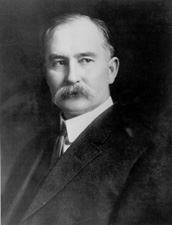Albert B. Fall
|
|
Albert Bacon Fall (November 26, 1861 - November 30, 1944) Senator from New Mexico and the Secretary of the Interior under President Warren G. Harding, notorious for his involvement in the Teapot Dome scandal.
Early Life and Family
Fall was born in Frankfort, Kentucky in 1861 to William R. and Edmonia Taylor Fall. Fall attended schools as a child in Nashville, Tennessee, but was primarily self-educated. At age eleven Fall was employed in a cotton factory, this early employment is most likely the cause of several respiratory health problems he suffered throughout his life. Due to these illnesses, as a young man Fall headed west looking for better climate. He lived in Oklahoma and in Texas, but eventually settled in Las Cruces in the New Mexico Territory.
On May 7, 1883, Fall married Emma Garland Morgan in Clarksville, Texas. The couple had four children: a son, John (Jack) Morgan Fall; and three daughters: Alexina Chase, Caroline Everhart, and Jouett Elliott. Both Jack and his sister Caroline died within a week of each other in 1918 from an influenza epidemic that was sweeping the nation. The family home was the Three Rivers Ranch in the Tularosa Basin of New Mexico. The Falls also maintained a home in El Paso, Texas.
During the Spanish-American War, Fall served as a captain of an infantry troop.
Career
Between the years of 1879-1881, we was employed as an educator while he studied law. He was admitted to the bar in 1891 and started practice immediately. He was appointed judge of the third judicial district in 1893.
As a member of the Republican Party, Fall was elected as one of the first U.S. Senator from New Mexico in the year 1912. It was widely known that he made a political alliance with Thomas B. Catron, the man who served alongside him, to ensure his own election. This controversy made Fall a target of the local Republican Party, as they believed Fall had not contributed to their efforts to secure New Mexico's statehood, and was not worthy of their nomination. Fall was also severely disliked by Democrats, in 1913, the Governor of the New Mexico purposefully forgot to sign the credential papers in an attempt to oust Fall by having a special election, which Fall inevitably won. Despite facing a bitter primary challenge in the election of 1918, Fall came out victorious. He served as chairman of the Committee on Expenditures in the Department of Commerce and Labor, was noted for his support of the suffrage movement and his extreme isolationist tendencies when America entered the first world war. After Catron was beaten in a primary election of 1916, Fall lost his only local political ally. However, since he had been elected, he had become close friends with the people who would later make up the infamous Ohio Gang, which inevitably secured him a cabinet position in March of 1921. While local politicians may have hated him, his popularity with the residents of New Mexico was reportedly very high anyway.
Teapot Dome Scandal
He was appointment to the position of Secretary of the Interior by Warren Harding in March 1921. Soon after his appointment, Harding convinced Edwin Denby, the Secretary of the Navy, that Fall should take over responsibility for the Naval Reserves at Elk Hills, California, Buena Vista, California and Teapot Dome, Wyoming. This last setting was used for the namesake of the scandal. Later that year, Fall decided that two of his friends, Harry F. Sinclair (Mammoth Oil Corporation) and Edward L. Doheny (Pan-American Petroleum and Transport Company), should be allowed to lease part of these Naval Reserves.
His failure to have competitive bidding for the reserves resulted in the Teapot Dome scandal trials between 1924-1929. The investigation found Fall guilty of conspiracy and bribery of $100,000 paid to him by Edward L. Doheny. Fall was jailed for one year as a result - the first former cabinet officer sentenced to prison as a result of misconduct in office.
Mr. Doheny was not only acquitted on the charge of bribing Fall, but Doheny's corporation forclosed on Fall's home in Tularosa Basin, New Mexico, because of "unpaid loans" which turned out to be that same $100,000 bribe.
He died after a long illness in El Paso, Texas, on November 30th, 1944.
| Preceded by: (none) | U.S. Senator from New Mexico 1912–1921 | Succeeded by: Holm O. Bursom |
| Preceded by: John B. Payne | U.S. Secretary of the Interior 1921–1923 | Succeeded by: Hubert Work |

